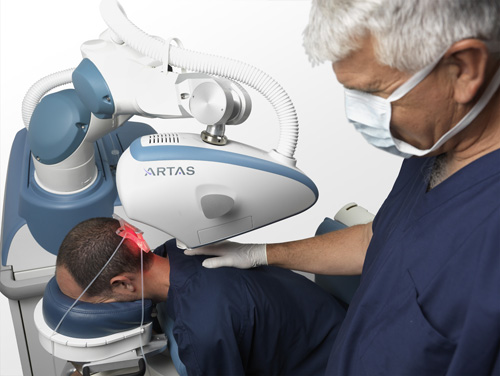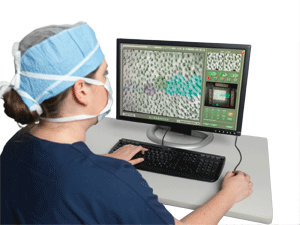Dr. Sparano is one of the few surgeons in the mid-Atlantic region, and on the east coast of the United States utilizing the breadth of advantages offered by the Artas® robotic system. Follicular unit extraction (FUE) has traditionally been preferred because of the technique’s capacity to eliminate the long incisional scar at the back of the scalp, associated with the strip procedure. FUE technique, however, has been a tedious one over the prior decades because of the inherent limitations imposed by the manual harvest of hundreds to thousands of individual follicular units. Other automated techniques (e.g., NeoGraft™ [see below]) indeed have their own limitations which Dr. Sparano believes can compromise surgical outcomes.
The technological evolution which has brought about the Artas® robot was an inevitable one. Use of the Artas® robot now allows an expeditious, safe, and programmable technique for FUE. Consequently, Dr. Sparano believes FUE technique has now become more often indicated than ever before. Patients can enjoy the benefits of small-, medium-, and large-sized surgeries, performed in a single or dual session, with maximized results, minimized hair transection rates, and no linear scar. Furthermore, the level of sophistication and programmability of the robot’s harvest allows for the selection of the very best hairs at optimal hair angles and inter-hair distances.
The Artas® robot uses a patented image-guided system with micron level precision. It has a robotic arm with a dual-needle punch mechanism which can be adapted to certain hair shaft diameters, level of curl, and patient ethnicity. Its video imaging system uses a complex user interface unlike anything in the clinical arena of hair surgery.
The robot’s extraction technique utilizes a double-punch arrangement with an inner, sharp punch and outer, dull punch. The inner punch is programmed to score the outermost layers of skin at a specific depth customized for each patient. The outer punch bluntly dissects carefully selected follicular units from the surrounding soft tissue, using complex algorithms designed to minimize trauma and transection of grafts. Everything from the patient’s positioning to the in-room magnified video monitors, are optimized for predictability and outcome success.
Many patients interested in the benefits of Artas® robotic hair transplantation inquire about the automated NeoGraft™ system. The NeoGraft™ system is not a robotic system and does not have the computer-driven, image-guided software for micron-level precise harvest of follicles as does the Artas® robot. The NeoGraft™ machine is a handheld surgical device which uses a combined air-pressure and suction-based technology for follicular unit extraction and implantation.
As with prior FUE handheld devices, the NeoGraft™ machine requires manual control by a human operator to select and harvest follicular unit grafts. Consequently, this technique is subject to human error, human imprecision, and human variation of skill and speed among technicians. Conversely, after the parameters of harvest are selected with use of the Artas® robot, the robot selects optimal follicular units for harvest and executes the harvest using a fast, image- and information-guided robotically performed methodology. The robot thereby minimizes the limitations of human error, human perception, and human fatigue. We believe this minimizes the transection rate of hair grafts, and maximizes the yield of harvest.
The NeoGraft™ machine works by first separating the provider-selected hair graft from the surrounding tissue using a rotating sharp punch. Then a suction-assisted attachment pulls the graft from the surrounding tissue through a tube into a small chamber. Dr. Sparano has maintained concerns about this technique for the following reasons:
Firstly, because the grafts are suctioned from the surrounding tissue after incision, but are still attached at their base, the impact of suction can shear the graft and compromise the necessary protective tissue of the graft. This increases the risk of graft drying, and trauma to the grafts across the remaining parts of the extraction technique, as well as during graft placement.
Secondly, as the harvested grafts are suctioned through the tubing into the storage chamber, they are continuously exposed to brisk dry air, increasing risks of injury and desiccation.
Thirdly, the NeoGraft™ machine does not take advantage of the dual, two-step, sharp-blunt mode of dissection which the Artas® robot or manual S.A.F.E. systems do. Instead it uses a single sharp-cutting tip and suction with limited follicle-sparing capability.
Finally, the needle-tipped device used to insert the grafts into incision sites at time of placement, uses an air pressure method of pushing the grafts into their sites. Thus, there is no clear indication of successful positioning within the site, or of whether any follicle becomes folded on itself at its base.
Consequently, it has been the opinion of Dr. Sparano and many other surgeons who have chosen to bypass use of the NeoGraft™ machine, that although the NeoGraft™ machine has offered innovative technology in the arena of hair surgery, its limitations are clear and may compromise graft survival and patient outcomes.
The Artas® system provides a level of technologic sophistication which minimizes the limitations of human variation across surgeon, and maximizes FUE success. At the same time it allows for careful human manipulation of follicles during the intricate extraction and placement processes.
Dr. Sparano is actively involved in the continuous feedback loop and research development within the company which created the Artas® robot – Restoration Robotics™. Continued developments are exciting for the near and distant future alike. Dr. Sparano’s robot offers the most advanced camera system, RPM device speed, Hair Studio™, and incision site making capacity. As we like to say commonly in our practice – the future in bright!


